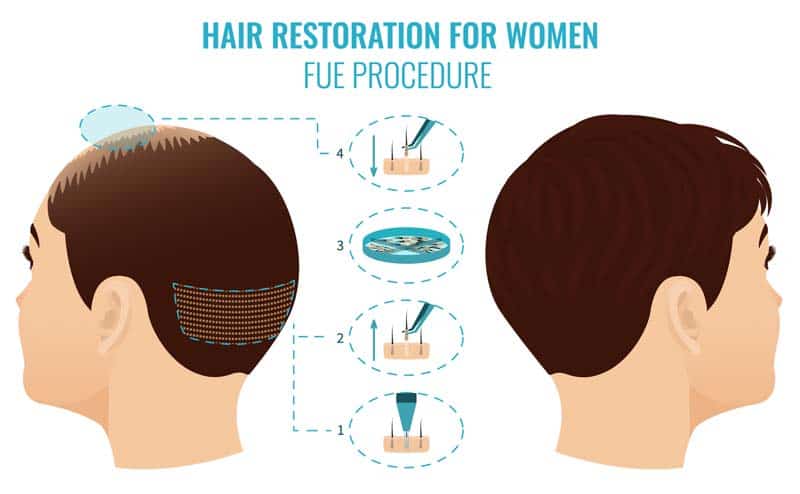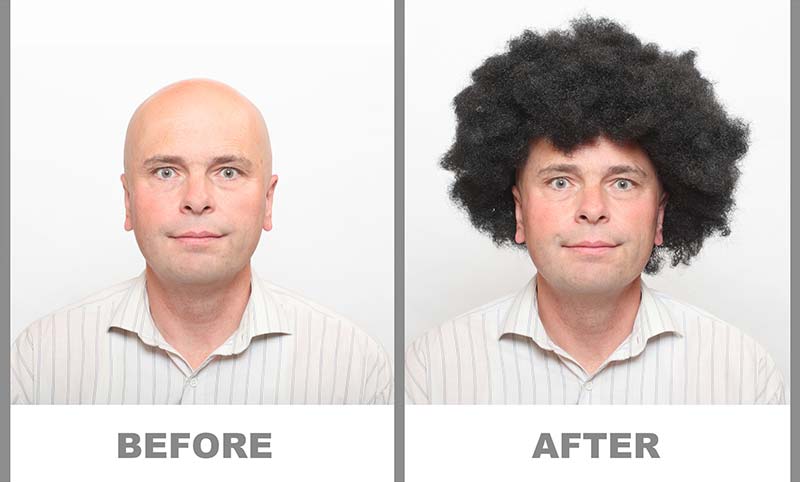Many factors go into selecting the perfect hair transplant clinic and surgeon. Probably the most critical choice is the type of procedure you prefer to undergo. Some patients, meanwhile, will first pick a clinic and then select the procedure type. Clinics that offer hair transplantation range in quality, the procedures they provide, and the instruments they use. Patients looking to find the best match must also consider each clinic’s reputation, location, the range of additional services, etc. Keep reading to learn how to measure each of these essential facets when selecting your hair transplantation clinic!
Clinics Typically Offer Two Main Hair Transplantation Types
Two methods of hair transplant are primarily available; Follicular Unit Extraction (FUE) and Follicular Unit Transplantation (FUT), often referred to as strip procedure. The quality of a hair transplant primarily depends on the surgeon’s and medical staffs’ skill and experience. That mentioned, the hair transplantation method also has a profound effect on the result’s quality.

FUT: An Older Method on the Outs
FUT always leaves a large, noticeable scar and warps hair growth patterns. The procedure involves extracting a swath of skin from the back or side of the patient’s head. This removed skin is then dissected for follicular grafts, which the surgeon then transplants into the recipient area. Post-op, patients must carefully tend to the extraction site for up to a few months. The noticeable lateral scar, meanwhile, limits the hairstyles patients may prefer as it short hairstyles rarely obfuscate it.
The main reasons patients would ever consider FUT is because the procedure is short, affordable and does not necessitate patients shave their head. However, all of these benefits are now available through younger, more effective transplantation methods. FUT is also more expensive then it initially seems. Scars the procedure leaves often require correction. Worse yet, FUT transplants have a reputation for lousy aging; as time wears on the grafts can become apparent and need correction.
FUE: The Newest Method Available and Patients’ Best Bet
The newest transplant available, FUE hair transplant involves extracting individual follicular units from the scalp and then placing them in the recipient area. Some experts at FUE can manage to conduct the procedure within a comparable timespan as FUT. By and large, though, FUE does take longer to perform, and patients must be prepared to sit still for long stretches of time. However, the results are well worth it!
Done right, FUE should leave little to no noticeable scarring. Hair growth patterns, meanwhile, never warp as the extraction site is diffuse. Far more precise than FUT, FUE also has a reputation for better, more convincing hairlines. FUE also ages better; since the transplants are a small number of follicles, at most, they never become egregiously noticeable. In fact, surgeons will use FUE to correct old FUT plugs and scars.
FUE is also now available in patch-shave and no-shave options, allowing patients who choose those types to keep their hairstyle. Prices for FUE are becoming more competitive but, overall, are still initially more expensive than FUT. The problems FUT causes, however, and the expense of correction, make FUE more cost effective in the long run.

Always Consider the Surgeon’s Training and Experience!
After deciding on the method they prefer, and their best bet is FUE, patients then must research into hair transplant physicians. Experience, training, and reputation matter a great deal. All reputable hair transplant surgeons trained under established experts; they often mention these figures on their website or bio.
A hair transplant surgeon’s experience is also critical. FUE takes time and regular practice to master; the amount of years a surgeon has conducted procedures, and the amount of patients they have helped, is often a decent indicator of their skill. However, surgeons’ capabilities can change with time. Patients should always ask to see recent examples of results, within the first year or two.
Finally, patients should consider each surgeons’ familiarity with the technique they prefer. As another section of this article will explain, there is any number of FUE variants. Patients who prefer a specific type of method, such as manual FUE, should make sure the given surgeon is familiar with it.
Last, consider if the surgeon solely focuses on hair transplantation or also does other procedures. Surgeons that only concentrate on hair transplantation, typically, have more experience and more knowledgeable about hair transplantation. However, surgeons who offer hair transplantation on top of other procedures are often quite capable too; all depends on their competence, understanding of different techniques and instrument preferences.

Also, Consider Surgeons’ Industry Reputation and Presence
The hair transplantation industry includes numerous organizations. Some are advocacy groups, but many are also professional organizations for surgeons and other professionals. The International Society of Hair Restoration Surgeons (ISHRS) is among the largest professional organizations but, in recent years, has been slow to adapt to FUE. The International Alliance of Hair Restoration Surgeons (IAHRS), meanwhile, functions as a consumer awareness group that informs patients and surgeons. Regional organizations like FUE Europe, FUE Magazine’s publishing organization, exist to help inform and train surgeons on a globally without interest in strip harvesting.
Membership in any hair transplant organization implies a few things about the surgeon. This includes the following:
- Active within the industry, which is essential to keep pace with advances
- Has a reputation for competence
- Networks within the hair transplant industry, to understand which instruments or techniques are viable
Membership in an organization is not the be-all, end-all of a surgeon’s reputation, however. Top surgeons often assume leadership positions or otherwise train physicians and lecture at gatherings. Hair transplant organizations also offer any number of accolades and recognitions to expert physicians as well.
Patients should also consider if the surgeon is researching advancement. Not all expert hair transplant surgeons research innovations and not all innovations are effective, however. One way patients can assess a surgeon’s reputability, if they are researching changes, is to see if other physicians endorse or are using these advancements or instruments.

The Clinics’ Medical Staff is Essential!
Finding a clinic with a knowledgeable, friendly, and educated staff is a must. You will also want to ensure that the clinic offers a consultation. An ideal clinic checks the patient’s hair density with an advanced program of some sort. This enables physicians to calculate both the available amount of donor follicles and the necessary amount of transplants.
Consultations also help rule out underlying conditions that may cause hair loss. As a particular note, the best hair restoration physicians know that not everyone is a good candidate; be wary of any clinic that pushes you to make a quick decision, particularly if in exchange for a discount.
A surgeon’s experience and skill is essential. Without a competent staff, however, even the best surgeon cannot hope to offer excellent results to patients. A hair transplant clinic encompasses many specialists aside from the surgeons. Hair transplantation is a team effort, and surgeons work with a team of nurses, surgical techs, and other experts to plan and complete procedures.
Staff members who assist in the procedure itself should be well trained and familiar with hair transplantation. They also must be familiar with the surgeon’s approach to the process and idiosyncrasies. An excellent surgical, tech, for instance, know when to call something to the surgeon’s attention. One of the highest requirements is familiarity with the clinic’s chosen instruments. Experience can mean very little if they are unpracticed with the procedure’s devices.

A Clinic’s Instruments Makes all the Difference
The devices and instruments a surgeon uses to play a vital role in the procedure and the results. Typically, the type of FUE variant surgeons uses dictates what tools they require.
Currently, there are four main types of FUE:
- Manual: The surgeon uses a necessary punch
- Mechanical: The surgeon uses a mechanical punch that makes extractions faster
- Automatic: The surgeon uses a device that automates extraction
- Robotic: The surgeon uses a robotic device for extraction
Each type of FUE has its benefits and detractions. Manual and mechanical FUE, however, is yielding better results currently. This is because automatic and robotic devices are still developing. Such devices presently available have higher transaction rates, or when a follicle being extracted is irreparably damaged, and a higher propensity to scar. Additionally, robotic and automatic FUE typically only applies to select patients that meet several characteristics. Patients should also be wary of automatic FUE, as device manufacturers have a reputation for enticing untrained doctors to offer hair transplantation who then use surgical techs.
The quality of instruments and devices also matter. Ideal FUE punches are so sharp they cannot be re-sharpened. Mechanical tools, meanwhile, also need to be of high quality and well maintained. Clinics that cut costs will reuse punches, significantly impacting results. They also will not use devices or solutions ideal for storing grafts, also decreasing further affecting results for the worse. Always inquire about what instruments the clinic uses and their manufacturer.

Check Before & After Photos and Ask for Patient References
Reputable clinics are proud of the results their patients enjoy! Most will include a before and after photo gallery showcasing the procedure’s effects and progress. Smart clinics will also use past patients as references to prospects; just be aware that disreputable clinics may incentivize patients to recommend them.
Patients should also be critical of before and after photo galleries. Honest clinics will use high-resolution photographs, intense lighting, and not photoshop any details. Some clinics, however, will use any number of tricks to make the results more impressive than they are in actuality. Such methods include using blur effects or lousy lighting to make results seem denser or otherwise more impressive.
Online patient reviews of the clinic can also be helpful for weeding out the good from the bad. A patient who has had a good experience and result often share this information with others in the hair loss community. Patients who are unhappy with their results, meanwhile, may be too ashamed to share their experience. Of course, there are also those who are quick to share their horror stories.
Make Sure the Surgeon Does the Majority of the Work
Make entirely sure the surgeon is doing the procedure’s majority. Experienced surgeons who care about their patients’ results will always play a huge, hands-on role in the system. It is their training and skill set, after all, that yields excellent results. FUE is labor-intensive, however, which means that surgeons occasionally need breaks. Such cases are when a nurse or tech temporarily fills in, one reason why a well-trained medical team is essential.
Unscrupulous surgeons, on the other hand, often designate the procedure to medical staff. The well-trained medical staff positively impact hair transplant results. However, medical staff lacks the overall training and qualification of a surgeon, even one without skill, experience or training in hair transplantation. Always ask the surgeon how much they personally commit to each procedure and the surgical staff’s roles.
Does the Clinic Offer Additional Treatments to Augment Results?
Hair transplantation from a good clinic typically yields excellent results. However, treatments are available that help augment said results even further. Such therapies include blood serums such as PRP, ACell, and stem cell serums. Such cell-based technology, if well made with an effective formula, spur faster recovery, faster activation of transplant follicles, and quicker growing, thicker hair. As with all other elements of the clinic, patients should always ask how the clinic makes treatments, the brand of their processors, etc.
Conclusion: Research, Research, Research!
Picking the best hair transplant clinic is a multifaceted and timely process. Be sure to do adequate research, to look at multiple clinics and not to rush into any decisions. Such analysis may seem daunting, but it is well worthwhile. Good hair transplant results offer benefits for a lifetime!



